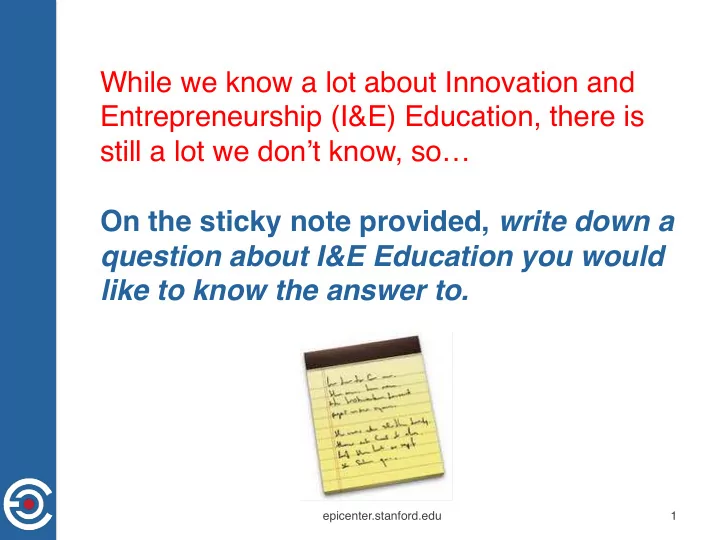

While we know a lot about Innovation and Entrepreneurship (I&E) Education, there is still a lot we don’t know, so… On the sticky note provided, write down a question about I&E Education you would like to know the answer to. epicenter.stanford.edu 1
Summit Supposition #1: Questions are core to research (and research is one component of increasing access to I&E education for engineering students). epicenter.stanford.edu 2
Summit Supposition #2: This research should be defined and carried out by researcher-practitioner partnerships . epicenter.stanford.edu 3
Summit Supposition #3: This research is a means to an end… to satisfy curiosity, to answer questions to inform/inspire action epicenter.stanford.edu 4
Exploring what we don’t know about entrepreneurship education for engineers S. Sheppard, S. Gilmartin, H. Chen, M. Besterfield-Sacre, N. Duval-Couetil, Project start date: Fall 2011 A. Shartrand, L. Moore, E. Costache, A. Fintoc, Q. Jin, C. Ling, F. Lintl, Grant number DUE-1125457 L. Britos Cavagnaro, H. Fasihuddin, and A. Breed
The Epicenter Research Summit August 4-5, 2015 Stanford University Overarching goal: Convene individuals who are actively involved in I&E education and research in order to learn from one another, discuss opportunities, and lay the groundwork for a unifying research agenda. epicenter.stanford.edu 6
The Epicenter Research Summit August 4-5, 2015 Stanford University Specifically: Create an event format for researchers and thought-leaders that allows them to… • develop connections • actively share ideas and insights • identify missing pieces and new opportunities • imagine next steps 7 epicenter.stanford.edu
Who was there? 70 attendees ranging from undergraduate students to industry professionals at 29 institutions/organizations: Arizona ¡State ¡University ¡ RH ¡Graham ¡Consul@ng ¡Limited ¡ Bloom ¡Energy ¡ SageFox ¡Consul@ng ¡Group ¡ Bradley ¡University ¡ Technical ¡University ¡Munich ¡(TUM) ¡ Clemson ¡University ¡ Texas ¡A&M ¡University ¡ Deutsche ¡Gesellscha< ¡für ¡Interna@onale ¡ Tu<s ¡University ¡ Zusammenarbeit ¡(GIZ) ¡ Union ¡College ¡ Epicenter ¡ ¡ University ¡of ¡Florida ¡ Furman ¡University ¡ University ¡of ¡Georgia ¡ Georgia ¡Tech ¡University ¡ University ¡of ¡Maryland ¡ Iowa ¡State ¡University ¡ University ¡of ¡PiRsburgh ¡ Kern ¡Family ¡Founda@on ¡ University ¡of ¡Southern ¡California ¡ Michigan ¡Technological ¡University ¡ University ¡of ¡Washington ¡ New ¡Mexico ¡State ¡University ¡ University ¡of ¡Wisconsin-‑Milwaukee ¡ Northwestern ¡University ¡ Virginia ¡Commonwealth ¡University ¡ Pennsylvania ¡State ¡University ¡ Purdue ¡University ¡ epicenter.stanford.edu 8
Knowledge sharing & discussion Example of Panel: Research on Students’ Entrepreneurial Development and Pathways Session notes: http://epicenter.stanford.edu/page/ epicenter-research-summit-session-notes epicenter.stanford.edu 9
Interactivity woven throughout the 2 days Early on: Poster Session v All attendees were invited to present a poster v Online gallery: http://epicenter.stanford.edu/page/epicenter-research- summit-posters 10 epicenter.stanford.edu
Interactivity woven throughout the 2 days Near the end: Re 3 session Re-cap: Summit takeaways Re-flect: Situate their takeaways Re-search: Generate new research questions 11 epicenter.stanford.edu
Interactivity woven throughout the 2 days 12 epicenter.stanford.edu
What we did with the 46 research questions from the Re-search Session: v Questions were transcribed (each authored by a different participant). v Analysis focused on categorizing questions and identifying themes across the questions. v Many questions fit into more than one category. v Categorization done by 2 researchers. epicenter.stanford.edu 13
Three Research Areas: Area 1: Linking Outcomes to Reform. (27 questions) Area 2: Understanding Student Diversity. (13 questions) Area 3: Examining Contexts. (12 questions) epicenter.stanford.edu 14
Three Research Areas Area 1: Linking Outcomes to Reform. Where does I&E fit into engineering education’s imagination? How can assessment strategies support connections between engineering education and entrepreneurship/innovation education as both evolve? Bilen et al., Byers et al., Creed et al., Duval-Couetil, Kisenwether et al., Jamieson and Lohmann epicenter.stanford.edu 15
Three Research Areas Area 2: Understanding Student Diversity. Not all engineering students are attracted to I&E for the same reasons; how does this come into play in framing learning goals? Graduates will take on a variety of engineering and non-engineering related professional jobs; how do I&E skills play roles in these various jobs (and what are the implications in how these skills are taught)? Brunhaver et al., Clarke and Antonio, Gerba, Hill et al., Jin et al., Scutt et al., Sheppard et al. epicenter.stanford.edu 16
Three Research Areas Area 3: Examining Contexts. Not all schools will have the same I&E learning goals for their engineering students, as the larger “ecosystem” of the school comes into play; how can a school identify their own appropriate learning goals? Besterfield-Sacre, Özaltin et al., Besterfield-Sacre, Shartrand, and Zappe, Bodnar et al., Duval-Couetil, Shartrand, and Reed-Rhoads, Gilmartin et al., Graham, Özaltin et al., Shartrand et al., Zappe et al. epicenter.stanford.edu 17
Where do your questions fall? Area 1: Linking Outcomes to Reform Area 2: Understanding Student Diversity Area 3: Examining Contexts Area 4: Other? Please write your topic number on your sticky note and add your name and email address. epicenter.stanford.edu 18
Next Steps 1) Collect your questions 2) Test the water on authoring “whitepapers” on: Linking Outcomes to Reform Understanding Student Diversity Examining Contexts epicenter.stanford.edu 19
Acknowledgements Supportive Epicenter colleagues Imaginative, dedicated, enthusiastic, and wise Summit attendees and co-hosts Insightful comments provided by reviewers of earlier drafts of this paper National Science Foundation under Grant No. 1125457 epicenter.stanford.edu 20
POSTER AT ENT RECEPTION JUNE 16 epicenter.stanford.edu 21
Recommend
More recommend